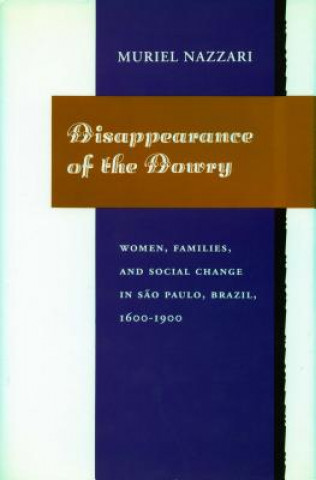
Kód: 04716069
Disappearance of the Dowry
Autor Muriel Nazzari
Examining the practice of dowry in the city of Sao Paulo, Brazil, and its surroundings for nearly three centuries, this book locates patterns of change that explain the dowry's virtual disappearance by the beginning of the twentie ... celý popis
- Jazyk:
 Angličtina
Angličtina - Väzba: Pevná
- Počet strán: 268
Nakladateľ: Stanford University Press, 1991
- Viac informácií o knihe

98.02 €

Skladom u dodávateľa v malom množstve
Odosielame za 10 - 14 dní
Potrebujete viac kusov?Ak máte záujem o viac kusov, preverte, prosím, najprv dostupnosť titulu na našej zákazníckej podpore.
Pridať medzi želanie
Mohlo by sa vám tiež páčiť
-

Discussions and More
77.12 € -4 % -

Deep Learning in Healthcare
225.08 € -

Circle to God
36.73 € -

Helical Springs Made of Polymer Nanocomposite
38.35 € -

Cloister and the Hearth ... Second Edition.
31.35 € -3 % -
![Collection of Poems in Six Volumes. by Several Hands. [Edited by Robert Dodsley.] Collection of Poems in Six Volumes. by Several Hands. [Edited by Robert Dodsley.]](https://media.libris.to/jacket/08000021t.jpg)
Collection of Poems in Six Volumes. by Several Hands. [Edited by Robert Dodsley.]
33.18 € -4 % -

14 Ways to Accomplish Your Mission
15.52 € -3 % -

Journey Shared
13.59 € -4 % -

Reality or Fantasy?
75.60 € -

Cities of God
67.27 € -

Homeric Moments
30.44 € -

Crop Circles, Jung, and the Reemergence of the Archetypal Feminine
21.81 € -6 % -

Ecotoxicology
469.66 € -

Advances in Cognition, Education and Deafness
65.85 € -

Murder, Mr Mosley
41.90 € -

All Mankind is One
22.11 € -4 % -

Advertising
589.51 € -10 % -

Anthony Trollope y Analisis del Discurso
63.11 € -

Giro Cultural de la Traduccion
37.34 € -

Acrylmalerei
19.27 € -4 % -

Warszawa zburzona i odbudowana wer. Włoska
9.73 €
Darujte túto knihu ešte dnes
- Objednajte knihu a vyberte Zaslať ako darček.
- Obratom obdržíte darovací poukaz na knihu, ktorý môžete ihneď odovzdať obdarovanému.
- Knihu zašleme na adresu obdarovaného, o nič sa nestaráte.
Viac informácií o knihe Disappearance of the Dowry
Nákupom získate 244 bodov
 Anotácia knihy
Anotácia knihy
Examining the practice of dowry in the city of Sao Paulo, Brazil, and its surroundings for nearly three centuries, this book locates patterns of change that explain the dowry's virtual disappearance by the beginning of the twentieth century. In the seventeenth century, 91 percent of the sample of propertied families gave their daughters dowries; in the nineteenth century, only 27 percent of the families did so. Furthermore, of those families who still gave dowries in the nineteenth century, many gave a dowry to only one or two of several daughters. In the seventeenth century, daughters were favorer over sons, for they received dowries that were much larger than what their brothers would inherit later on. By the nineteenth century, parents were spending much money on their son's education while giving their daughters smaller dowries or no dowries at all. A seventeenth-century dowry included land, houses, cattle, and Indian and African slaves, so that the bride contributed most of the support of the newlyweds. By the end of the nineteenth century, the bride contributed little to the support of the married couple. As the practice of dowry declined and disappeared, it was accompanied by an ideological change. From viewing dowry as something that ensured their daughters' well-being, people came to see dowry as a way men sold themselves for easy money instead of supporting their families with hard work. Why did a practice that had been considered a duty stop being a duty? Why did property-owning families modify their behaviour regarding sons and daughters? And what were the consequences for the women of these families? Although the dowry declined and disappeared elsewhere - in most of Europe, in England, and in Mexico - this is the first book to study and document its disappearance. The author argues that the practice of dowry altered because of changes in society, the family, and marriage. Brazil changed from a hierarchical society in which status, family, and patron-client relations were primarily to a more individualistic society in which contract and the market increasingly reigned. The family changed from being the locus of both production and consumption to being principally the locus of consumption, while 'family' and 'business' became formally separated. m arriage was transformed from predominantly a property matter to an avowed 'love' relationship. At the same time, the strong authority of the patriarch over adult sons and daughters was greatly diminished.
 Parametre knihy
Parametre knihy
Zaradenie knihy Knihy po anglicky Society & social sciences Society & culture: general Social groups
98.02 €
- Celý názov: Disappearance of the Dowry
- Podnázov: Women, Families, and Social Change in Sao Paulo, Brazil, 1600-1900
- Autor: Muriel Nazzari
- Jazyk:
 Angličtina
Angličtina - Väzba: Pevná
- Počet strán: 268
- EAN: 9780804719285
- ISBN: 0804719284
- ID: 04716069
- Nakladateľ: Stanford University Press
- Hmotnosť: 548 g
- Rozmery: 229 × 152 × 19 mm
- Dátum vydania: 01. October 1991
Obľúbené z iného súdka
-

Women Who Run with the Wolves
11.76 € -

Freedom Writers Diary
15.42 € -11 % -

Think Like a Monk
15.62 € -24 % -

Orientalism
11.25 € -21 % -

How Europe Underdeveloped Africa
22.82 € -6 % -

Desert Flower
10.14 € -24 % -

Why Does He Do That?
16.43 € -12 % -

Letters to a Young Muslim
12.17 € -23 % -

Eros and Mysteries of Love
18.05 € -14 % -

Life After Darkness
21.50 € -20 % -

Puer Tea
44.54 € -

Womanhood
21.81 € -23 % -

Complete Book of Pilates for Men
19.17 € -20 % -

JFK - 9/11
33.28 € -

Sword of No-sword
27.39 € -5 % -

Gypsy Identities 1500-2000
68.49 € -

Colloquial Yiddish
67.48 € -

Servitors of Empire
20.79 € -2 % -

Gerotranscendence
144.50 € -

Northwest Coast Indian Art
30.44 € -2 % -

Qur'an
32.46 € -23 % -

When God Was A Woman
19.68 € -3 % -

The Mastery of Love
12.78 € -15 % -

Vintage Menswear
16.53 € -9 % -

Who Cooked the Last Supper?
19.88 € -6 % -

Women Who Run With The Wolves
14.50 € -24 % -

The Way of Men
13.89 € -19 % -

The Autobiography of Malcolm X
10.54 € -7 % -

Second Sex
16.43 € -23 % -

Goddesses in Everywoman
12.17 € -23 % -

Talking with Female Serial Killers - A chilling study of the most evil women in the world
11.05 € -23 % -

Intellectuals and Society
22.21 € -21 % -

Women in the Qur'an
20.79 € -2 % -

Erotic Bondage Book
15.21 € -15 % -

Zami
11.05 € -23 % -

Nine Years among the Indians, 1870-1879
30.03 € -

Dark Emu
16.43 € -23 % -

Childhood and Society
16.23 € -19 % -

Happy City
12.17 € -23 % -

The Male Nude
18.36 € -9 % -

The Bell Curve
18.56 € -23 % -

We Should All Be Feminists
7.50 € -25 % -

Empire of the Summer Moon
14.30 € -23 % -

Radium Girls
11.05 € -23 % -

Dance of Anger
11.05 € -23 % -

Beauty Myth
14.30 € -23 % -

Muqaddimah
21.91 € -15 % -

TROUBLEMAKER
15.52 € -18 % -

Ladies' Book of Etiquette and Manual of Politeness
13.08 € -18 %
Osobný odber Bratislava a 2642 dalších
Copyright ©2008-24 najlacnejsie-knihy.sk Všetky práva vyhradenéSúkromieCookies


 21 miliónov titulov
21 miliónov titulov Vrátenie do mesiaca
Vrátenie do mesiaca 02/210 210 99 (8-15.30h)
02/210 210 99 (8-15.30h)